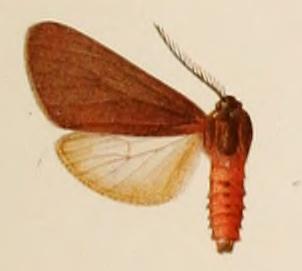
Euchaetes egle, the milkweed tiger moth or milkweed tussock moth, is a moth in the family Erebidae and the tribe Arctiini_(erebid_moths), the tiger moths. It is a common mid- through late-summer feeder on milkweeds and dogbane. Like most species in this family, it has chemical defenses it acquires from its host plants, in this case, cardiac glycosides. These are retained in adults and deter bats, and presumably other predators, from feeding on them. Only very high cardiac glycoside concentrations deterred bats, however. Adults indicate their unpalatability with clicks from their tymbal organs.

The Phaegopterina are a subtribe of tiger moths in the Arctiini tribe, which is a part of the family Erebidae.

Euchaetes is a genus in the subtribe Phaegopterina in the family Erebidae. It was described by Thaddeus William Harris in 1841.
The Euchaetina were a subtribe of woolly bear moths in the family Erebidae. The moths are found in North and Central America. The subtribe was reclassified as part of the subtribe Phaegopterina.

Euchaetes fusca is a moth of the family Erebidae. It is found from the south-western United States to Costa Rica.
Euchaetes albicosta is a moth of the family Erebidae. It was described by Francis Walker in 1855. It is found from Texas, south to Mexico and Nicaragua.
Euchaetes antica is a moth of the family Erebidae. It was described by Francis Walker in 1856. It is found from Arizona and New Mexico in the US, south to Mexico, Nicaragua, Honduras and Guatemala.
Euchaetes bicolor is a moth of the family Erebidae. It was described by Walter Rothschild in 1935. It is found in São Paulo, Brazil.
Euchaetes bolteri is a moth of the family Erebidae. It was described by Richard Harper Stretch in 1885. It is found from the US states of Texas and New Mexico to Mexico and Costa Rica.
Euchaetes castalla is a moth of the family Erebidae. It was described by William Barnes and James Halliday McDunnough in 1910. It is found in the US state of Arizona.
Euchaetes cressida is a moth of the family Erebidae. It was described by Harrison Gray Dyar Jr. in 1913. It is found in the US state of Texas and Mexico.
Euchaetes elegans, the elegant pygarctia, is a moth of the family Erebidae. It was described by Richard Harper Stretch in 1874. It is found in the US states of California, Arizona, New Mexico, Nevada and Texas, and in Mexico, Guatemala, Panama and Colombia.
Euchaetes expressa is a moth of the family Erebidae. It was described by Henry Edwards in 1884. It is found in Mexico and Costa Rica.
Euchaetes gigantea is a moth of the family Erebidae. It was described by William Barnes and James Halliday McDunnough in 1910. It is found in the US states of Arizona, New Mexico and Oklahoma.
Euchaetes pannycha is a moth of the family Erebidae. It was described by Harrison Gray Dyar Jr. in 1918. It is found in Mexico.
Euchaetes perlevis is a moth of the family Erebidae. It was described by Augustus Radcliffe Grote in 1882. It is found in the US states of Arizona, New Mexico and Texas.
Euchaetes promathides is a moth of the family Erebidae. It was described by Herbert Druce in 1894. It is found in Mexico.
Euchaetes psara is a moth of the family Erebidae. It was described by Harrison Gray Dyar Jr. in 1907. It is found in Mexico.
Euchaetes rizoma is a moth of the family Erebidae. It was described by William Schaus in 1896. It is found in Brazil.
Euchaetes zella is a moth of the family Erebidae. It was described by Harrison Gray Dyar Jr. in 1903. It is found in the US states of Arizona, California, Nevada, New Mexico, Oklahoma and Texas.




